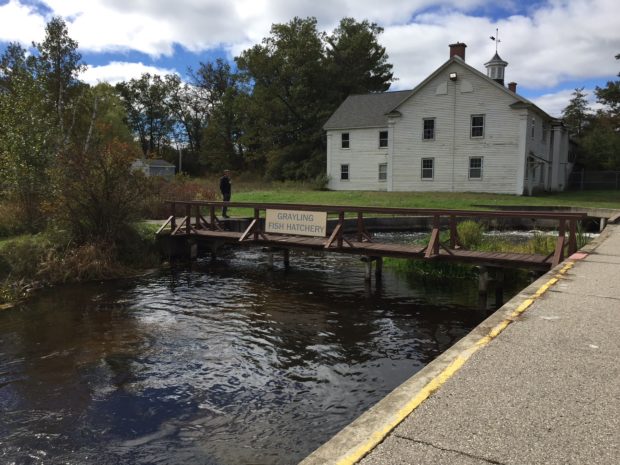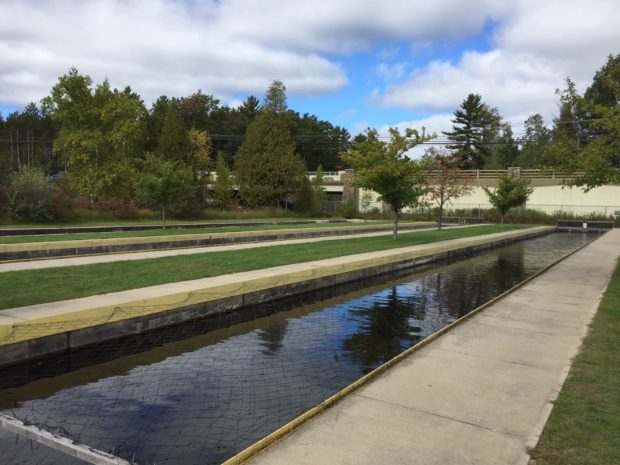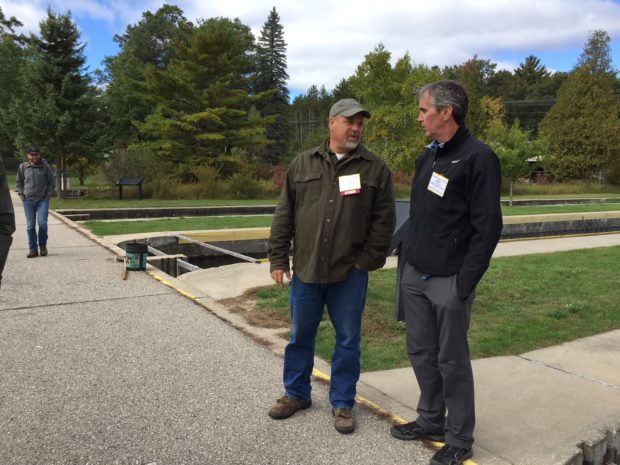
The Grayling Fish Hatchery facilities. Image Sara Alfaro Cornejo
By Sara Alfaro Cornejo
The Au Sable River, one of the most pristine water bodies in North America thanks to its stable base flow and temperatures, has been at the center of a dispute that is often repeated when it comes to projects with an environmental impact that faces organizations that protect the environment and companies that affect it.
There is a constant natural murmur among the green and yellowish leaves of the Manistee National Forest in the Northern Lower Peninsula of Michigan.
It’s the channel of the Au Sable River and characterized by its freshwater. It’s located above nearly a thousand feet of glacial till – a mixture of gravel and sand – that gives it the most stable temperatures and base flow–the portion of the stream flow that is sustained between precipitation events– of any river in North America.
It’s not just that: This ecological community serves as home to many species, including naturally reproducing populations of coldwater fish like brook, brown and rainbow trout. Thanks to this, it’s become an attraction for fly fishing, recreational water sports such as kayaking and tourism in general.
But it has also been a source of aquaculture.
While the river flows and follows its course, the confluence of two of its branches – the East and Main branches – passes less than a kilometer (two-thirds of a mile) from the Grayling Fish Hatchery in Crawford County. The hatchery belongs to the Harrietta Hills Trout Farm, located 75 miles away.

The hatchery raceways used to be tourist attractions, allowing visitors to fish from them for trout. Image: Sara Alfaro Cornejo
Vegetation surrounds the fish farm, and the water channel is heard in the distance. Only an outdoor corridor, with rectangular pools full of trout on the sides, separates it from the entrance of what appears to be a house at the end of the facility.
This is where owner Daniel Vogler and his family established the hatchery in 1914, as a poster that hangs in the visitors’ booth says.
“Currently, the United States only produces 8% of the seafood that we consume, so the growth of domestic production is important for the long-term safety of seafood products in the country,” Vogler explains, arguing that its production helps to supply the population with fish.
As most of the marine products consumed in the United States are imported from Asia, a region that is growing rapidly in population and middle class, Vogler says this mean less seafood available for import in the future. “If Americans want to continue eating fish and seafood, we’ll have to produce more of it ourselves,” he explains.
About 15 minutes by car from the hatchery, and also among the reddish fall leaves of trees, is the Michigan headquarters of the Sierra Club, an environmental protection organization with more than 3.5 million members in the United States.
For four years, the club has tried to get the Grayling hatchery closed. The reason? The facility would not divert water from the river for its use and discharge it back to the river. Rather, it let the water flow through the facility, entering at the north end and exiting at the bottom end.
The trout farm also has operated since 2012 as a seasonal tourist attraction, where visitors were allowed to feed and fish for trout from hatchery raceways. In 2014, the hatchery sought to expand, and to do so it had to ask for a permit in which it certified it would not degrade the Au Sable channel. The Sierra Club and other environmentalists opposed the issuance of the permit and development of the Grayling hatchery, declaring that its demonstration of non-degradation was insufficient.
“The permit in question is based on a demonstration of insufficient anti-degradation by Harrietta Hills,” the Sierra Club’s petition to the Michigan Department of Environmental Quality said. The petition, facilitated by Marvin Roberson, the organization’s forestry ecologist, reads, “And it does not establish limits or monitoring requirements for the discharge of harmful organisms, including, but not limited to, whole fish, parasites, viruses (including VHS, or ‘whirling disease’), exotic or invasive species and other microorganisms contained in fish excrement.”
 But Vogler says, “There is no reliable scientific evidence to show that the small amount of nutrients we discharge has a negative impact on the river’s ecosystem. In fact, examination of that available data suggest that the river would benefit from these nutrients if we had continued to operate.”
But Vogler says, “There is no reliable scientific evidence to show that the small amount of nutrients we discharge has a negative impact on the river’s ecosystem. In fact, examination of that available data suggest that the river would benefit from these nutrients if we had continued to operate.”
However, the Sierra Club asserted that closing the hatchery would prevent “irreparable deterioration to the delicate, unique ecology and water quality” of the Au Sable River.
Crossing borders
Four years after the permit battle began, the story is a whole lot of different. Under a settlement announced in September, the Grayling hatchery will end commercial aquaculture while a local conservation group, Anglers of the Au Sable, will run the hatchery as an educational and tourism attraction. The agreement ends a four-year court battle.
“Litigation in the United States is extremely expensive, even if the evidence is on your side,” says Vogler. “We do not have the financial capacity to navigate the years of litigation that are required to prevail in the courts. We trust that if we had taken this case to trial, we would have won.”
Situations in which pro-environmental organizations have a voice and active role in stopping projects are gaining strength every day and go far beyond the U.S. borders.
For example in Chile, a country that has been developing mining for decades, communities that ensure the least possible impact have been gaining important positions.
Dominga is a project that sought to extract iron and copper concentrates in the region of Coquimbo, in the north of the country. The project contemplated creation of an open-pit mine, in addition to construction of its own port to export its production and a desalination plant to avoid using freshwater from the area.
Similar to the Harrietta Hills situation, construction would be located near a unique ecological community: about 18 miles from the Humboldt Penguin natural reserve, where 80 percent of the world’s population of this endangered species lives, in addition to whales and chungungos, an otter species.
Light, sound and air pollution, as well as possible spills and accidents in the port, worried the authorities who, after a series of legal procedures, finally rejected the project in 2017. “The project does not adequately take care of the eventual significant impacts on the environment and the health of people,” Marcelo Mena, Chile’s environment minister at the time, said at a press conference.
Meanwhile, Iván Garrido, the chief executive office of Andes Iron, the firm that owns the project, told the BBC that Dominga’s Environmental Impact Study had been processed for 3½ years “with deep technical and scientific studies, and with an investment of more than US $300 million.
“The project would have even been approved in the United States, Australia and Canada,” he added.
That way, Dominga provoked a series of opinions not only within the mining industry, the environmental branches of the government or experts in the area, but also among citizens and groups protecting the environment. The fishers in the area and Oceana, an organization that looks after conservation of marine ecosystems, took a series of legal actions to stop the project.
At the beginning of 2018, a ruling by the First Environmental Court of Antofagasta of Chile left the possibility that the Dominga project could materialize again, giving way to an appeal by different communities.
That’s just one of the many national and international examples that have led companies and human rights groups to discuss the prevalence of the ecosystems that surround us, something that will recur more and more as industry and the environment continue to face each other.
Sara Alfaro Cornejo was a participant in a recent Knight Center for Environmental Journalism workshop for Chilean journalists and journalism students.
